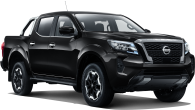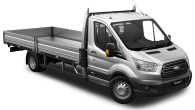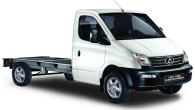The new Isuzu D-Max has impressed many: it’s well-built, very comfortable as a daily driver, very capable as a weekend off-road tourer and it’s packed with driver-assist tech.
We’re testing it over a few months to see how it performs day to day, week to week, and in a variety of situations: family life, camping trips, and with a fair bit of tough off-roading thrown into the mix for good measure.
Isuzu D-MAX 2021: X-Terrain (4X4)
| Engine Type | Diesel Turbo 4, 3.0L |
|---|---|
| Fuel Type | Diesel |
| Fuel Efficiency | 8.0L/100km (combined) |
| Seating | 5 |
| Price From | $43,010 - $50,050 |
| Safety Rating |
|
Part 1: March/April 2021
The new Isuzu D-Max has consistently impressed many of us here at CarsGuide headquarters: it’s well-built, very comfortable as a daily driver, very capable as a weekend off-road tourer and it’s packed with driver-assist tech.
But there’s been a price increase for the line-up – a $1000 rise for our long-term top-of-the-range X-Terrain – and the Isuzu ute faces stiff competition in an ever-crowded market.
We’re testing it long-term to see how it actually performs day to day, week to week, and in a variety of situations: family life, weekend camping trips, and with a fair bit of tough off-roading thrown into the mix for good measure.
.jpg)
This is the first instalment of our long-term report on the D-Max. How is it doing so far? Read on to find out.
The D-Max X-Terrain can be bought for a current driveaway price of, at time of writing (late April), $59,990.
Our long-term X-Terrain as tested costs $62,725.45, because that figure factors in the Marble Pearl White premium paint ($500), total accessories and stamp duty ($2235.45).
As standard, the X-Terrain’s features list is a considerable one and includes, but is certainly not limited to, leather-accented upholstery with leatherette across interior trims, premium leather steering wheel and gear knob, eight-way power adjustable driver’s seat with power lumbar support, dual zone air conditioning, a 9.0-inch multimedia display with sat-nav, Android Auto and wireless Apple CarPlay, an eight-speaker sound system, remote engine start, smart entry and start … (draws a breath) … as well as roof rails, an under-rail tub liner, a hard roller tonneau cover (not powered), sports bar, and front and rear underbody spoilers.
.jpg)
The D-Max has a five-star ANCAP rating, from testing in 2020, and eight airbags (including a centre airbag to protect front-seat occupants).
Isuzu’s Intelligent Driver Assistance System (IDAS), standard across the entire range, incorporates active and passive safety features. It has AEB, forward collision warning, blind spot monitor, Lane Keep Assist, Emergency Lane Keeping and Lane Departure Prevention, adaptive cruise control, reversing camper with rear cross traffic alert, traffic sign recognition, auto headlights and high beams, auto windshield wipers and more.
It has a dark grey metallic front grille, ’X’ (as in ‘X-Terrain’) branding, and 18-inch dark grey metallic alloy wheels on 265/60R18 Bridgestone 684II HT tyres.
.jpg)
Premium exterior paint colours include the aforementioned Marble White Pearl (exclusive to LS-U and X-Terrain), as well as Magnetic Red Mica (exclusive to LS-U and X-Terrain) and Volcanic Amber metallic (exclusive to X-Terrain).
The standard range of paint finishes include Basalt Black mica, Cobalt Blue mica, Mercury Silver metallic, Obsidian Grey mica, and Mineral White.
In terms of looks, the X-Terrain has nice outdoorsy-lifestyle touches such as side steps, roof rails, aero sports bar, an under-rail tub liner, a hard roller tonneau cover, and front and rear underbody protection.
To give you a clear idea of the X-Terrain’s dimensions, check out this table (below).

The D-Max range is powered by a 3.0-litre four-cylinder turbo-diesel engine – producing 140kW at 3600rpm and 450Nm at F1600-2600rpm – and it’s teamed with a six-speed auto.
This is a solid and proven combination, operating more in the realm of good old-fashioned grunt ably bolstered by modern-day driver-assist tech, rather than wholly relying on slick-does-the-trick electronic wizardry to deliver a safe and steady driving experience.
.jpg)
It has a dual-range transfer case (with high-and low-range 4WD), an off-road traction control system and a rear diff-lock. The driver is able to shift from 2H (two-wheel drive, high range) to 4H (4WD high range) while on the move, and up to speeds of 100km/h, The diff-lock may only be engaged when the vehicle is in 4L (4WD low range).
The interior is a neat, well-designed and -built practical space.
It’s very pleasant with a real premium feel about everything – leather trim and soft-touch surfaces all over the place top off the cabin’s general prestige – and it’s very comfortable.
.jpg)
Useful storage spaces abound including the dual glovebox, a deep centre console, outboard pop-out cupholders, a pocket-dump space in front of the shifter, as well as door pockets.
There is also a shallow lidded space atop the dash but we’ve had trouble opening it via its push-button, so we’ve largely ignored it.
The multimedia system is generally pretty good, with its massive screen and easy-to-operate functionality, although the on-screen controls tend to grate on the user a little, as does the ‘bleep’ sound that accompanies every press of the system’s buttons, be they on-screen or steering-wheel-mounted. (This sound, I assume, can be switched off somewhere in Settings, but I’m yet to take the time enough to rectify that little niggle.)
.jpg)
From the moment you climb into the X-Terrain and get your driving position correct – by way of an eight-way power-adjustable leather-accented driver’s seat – and set your leather-bound, reach and rake-adjustable steering wheel, to the time you exit it at your day’s final destination after a long stint ‘in the saddle’, this D-Max is a very decent daily driver.
The steering is precise, nicely weighted at all speeds, and rewards the driver who likes an engaging driving experience..
It has a 12.5m turning circle but it never feels cumbersome to steer through busy parked-in streets or along tree-shrouded bush tracks.
The engine and six-speed auto work well together, but as a solid, rather than heart-racing, combination – it’s a pairing built for steady grunt work under load, not stunning 0-100km/h sprint times. Having said that though, it has enough get-up-and-go to slot into a narrow gap in traffic from a standing-start and it can be relied upon to accomplish smooth and safe overtaking moves.
Speaking of the engine, there is some general low-level diesel noise – and that grows increasingly gruff when the driver gets on the throttle hard – but it’s not annoying, only noticeable.
.jpg)
The X-Terrain has a nice balanced on-road posture and its suspension – independent front and three leaf-spring rear – helps to produce a much nicer and more comfortable ride all-round than ever experienced in the previous-gen D-Max.
Unladen, the D-Max can tend towards being a little skippy at the back end – the same as any ute – but, of course, any weight in the tray, helps to swiftly rectify that.
High levels of comfort help to keep driver and passengers happy – and I haven’t heard any whining from the kids yet, even after a few hours in it to and from one of our holiday campsites.
Overall, the X-Terrain is very impressive as a daily driver, but its real-world 4WDing prowess is never too far away either.
To give you a clear idea of off-road-relevant figures, check out this table (below).

The suspension is so well sorted now that even through sections of mild corrugations on back-country bush tracks, the X-Terrain manages to soak up most lumps and bumps and maintain a settled composure. It takes a deep pothole to ever rock this D-Max off its game.
The other good news is that the X-Terrain is also even better than it was before when undertaking low-speed, low-range 4WDing.
The D-Max has a dual-range transfer case – with high- and low-range 4WD – as well as a recalibrated off-road traction control system and a rear diff lock as standard.
The engine-and-auto combination are at home trucking the D-Max along through difficult 4WD set-piece hill-climbs at low speeds and, with 400 of the D-Max’s 450Nm of torque tappable across a 1400rpm-3250rpm range, it maintains an unfussed demeanour for the duration, no matter how steep, rocky or tricky the terrain is. Plenty of useable torque at low revs makes a marked difference, so driving the X-Terrain off-road really is quite a low-stress affair.
.jpg)
Approach, ramp-over and departure angles (check the table, above) and wheel travel are decent for a showroom-standard dual-cab ute.
There were issues with the efficacy of the previous-gen D-Max's off-road traction control system – a heavy right boot was often needed to monster your way through tougher terrain – but Isuzu seems to have resolved those with its new line-up, and now steady throttle is enough to help you achieve safe, controlled progress.
So, the new D-Max's low-range gearing and traction control are very effective, but now this ute is also bolstered by the introduction of a rear diff-lock, something that had been sorely missing from the previous-gen D-Max’s off-road set-up.
The diff lock can be engaged at speeds up to 8km/h and only when you're in four-wheel drive low-range (4L). It will disengage when you hit 30km/h or more. Note: when you engage the diff lock, off-road traction control is disengaged.
It’s a great addition and one that’ll help to keep you moving along off-road on traction-compromised terrain and ultimately give you more peace of mind on the tracks.
.jpg)
Hill descent control is impressive, consistently holding us to a steady controlled 3-4km/h while driving down some of our steep set-pieces.
There are a couple of not-so-positive things that have to be mentioned though but, luckily for D-Max fans, these niggles can be easily rectified.
I’ve noted before that the new D-Max, while having a claimed 240mm ground clearance, feels lower and more vulnerable to scrubbing dirt with its undercarriage than it should. This is the way of most modern utes though. The new D-Max does have a longer wheelbase and shorter body than before and the fact it has pronounced side steps doesn’t help either, but this low-rider sensation can be negated with slower, more considered driving, but should be fixed with an aftermarket suspension / lift.
Another niggle is the X-Terrain’s as-standard 265/60R18 Bridgestone 684II HT tyres, wrapping those big pie-plate rims. These tyres are well suited to on-road driving, but fall well short of being ideal for use off-road, and should be replaced with a set of new more-aggressive all-terrains.
Check out this table (below) are important weights and capacities because if you’re buying a ute, you want to know how much stuff you can pack into it and tow with it.

It has a robust tub liner, with two tie-down points (not enough) near the rear end of the tray and the hard tonneau roller-cover that is manually opened and closed and, when opened, retracts into a roller drum at the cabin end of the tray.
We have taken it away on one family camping trip so far, and used it as a support vehicle – just to drop off gear and supplies at the campsite – on another.
A tonneau cover is handy for protecting your gear from prying eyes (and light fingers), and also the weather, but it limits the tub’s packing flexibility. If you have so much gear you have to leave the hard roller-cover open, even partially (which we did), you only have two tie-down points with which to secure the load – not ideal. The roller-cover drum also takes up some packing space.
.jpg)
The D-Max has claimed fuel consumption of 8.0L/100km (on a combined cycle), but I’ve recorded an actual fuel consumption on test so far, fill to fill, of 8.8L/100km.
It has an 76-litre fuel tank.
The D-Max is covered by a six-year/150,000km warranty, up to seven years no-cost roadside assistance (when serviced through IUA dealers) and seven-year capped price servicing program.
Service intervals (set every 12 months or 15,000km, whichever occurs soonest) cost $389 (15,000km), $409 (30,000km), $609 (45,000km), $509 (60,000km), $299 (75,000km), $749 (90,000km), and $409 (105,000km).
Watch out for more updates – and a video!
Acquired: March 2021
Distance travelled this month: 1160km
Odometer: 6463km
Average fuel consumption for April: 8.8L/100km (measured at the pump)
Part 2: May 2021
Our new D-Max X-Terrain, on a three-month test-loan from Isuzu, has had a rather quiet month this month, only logging 959km of mostly blacktop driving with some sections of gravel and dirt tracks, and a few kilometres of four-wheel driving (high- and low-range).

It spent a half-day in May as a support vehicle on a CarsGuide photography shoot, but the lion’s share of its duties this month has been limited to functioning as a daily driver.
And it continues to do very well. First impressions from the launch have remained: it’s a well-built, capable and comfortable ute.
A few minor niggles remain though but, as mentioned before, can be swiftly resolved:
1. Ground clearance is listed as 240mm ground clearance, but the D-Max feels more vulnerable to touching earth with its undercarriage than it should – in its defence though, most modern utes feel this way because they’re all compromised to favour on-road comfort, rather than off-road efficacy. The new D-Max’s longer wheelbase and shorter body and pronounced side steps don’t help negate that sensation either, but sensible driving will go some of the way to resolve that ‘low rider’ feeling, and can be further addressed with aftermarket suspension / lift to improve off-road-relevant angles.

2. The X-Terrain’s standard 265/60R18 Bridgestone 684II HT tyres are good on-road tyres but, if you’re aiming is to use your D-Max as an off-road tourer, replace those with a set of more-aggressive all-terrains as soon as humanly possible.
3. The hard roller-top tonneau cover looks nice and offers your tub-stored gear protection from the elements and crooks, but the roller top itself can become gummed up with leaves, bush debris and any dirt and grit your tyres have kicked up while you’re driving out bush. Also, the actual operation of it – locking/unlocking, and opening and closing – isn’t as smooth as you’d expect. And that’s not just me identifying this as a minor issue – one of our videographers (an experienced ute owner) had the same strife with it as I did. Maybe our roller top just needs to be ‘run in’ a bit longer.
All in all, the X-Terrain is an appealing 4WD ute and none of us on the CarsGuide team are ever shy of grabbing the keys and driving it if they have the opportunity.
Acquired: March 2021
Distance travelled this month: 959km
Odometer: 7422km
Average fuel consumption for May: 8.6L/100km (measured at the pump)

Part 3: May/June 2021
Our three-month stint with the top-spec D-Max, the X-Terrain, has drawn to a close and it is with a fair bit of disappointment that we returned it to Isuzu as this impressive ute has become a much-appreciated member of the CarsGuide test fleet.
Its final month was generally quiet in terms of total distance travelled, but it was pretty bloody busy in terms of dirt-track driving and low-range 4WDing, as we took it on several day-long fast-blasts and, of course, our final video day of filming it here in NSW.
.jpg)
What’s also interesting is the fact this top dog D-Max consistently attracted plenty of admiring looks from numerous fellow motorists – and not all of them were other D-Max drivers either; many owners of other utes have seemed just as enamoured by this Isuzu – and I’ve fielded plenty of questions about the X-Terrain from curious 4WDers out bush.
As a daily driver, the X-Terrain has performed very well, with a real unfussed but premium feel about it for driver and passengers, and everyone in my mob soon became very comfortable with it as their preferred form of conveyance: to and from school, to and from sport (so much sport), and to and from … everywhere.
.jpg)
Nice acceleration, smooth-shifting transmission, quiet low-revs open-road cruising ability, as well as a super-comfortable and practical cabin – all of these characteristics, and more, combine to yield an overall pleasant on-road travel experience, no matter how long your drive-time is.
And the D-Max also cemented its reputation with us as a solid off-roader over the course of many 4WD excursions.
It was never atrocious in on rough terrain in the past, but it was let down by its off-road traction control system and the absence of a diff-lock. Well, as you might already know, this new-gen D-Max has recalibrated off-road traction control and a rear diff-lock.
.jpg)
The diff lock can be engaged at speeds up to 8km/h and only when you're in four-wheel drive low-range (4L). It will disengage when you hit 30km/h or more. Note: when you engage the diff lock, off-road traction control is disengaged.
It has a dual-range transfer case (with high-and low-range 4WD), an off-road traction control system and a rear diff-lock. The driver is able to shift from 2H (two-wheel drive, high range) to 4H (4WD high range) while on the move, and up to speeds of 100km/h, The diff-lock may only be engaged when the vehicle is in 4L (4WD low range).
.jpg)
There’s ample useable torque at low revs, decent hill descent control, and adequate wheel travel.
The D-Max continues to feel a touch low and it does seem vulnerable to scrubbing dirt with its undercarriage, but it has a listed 240mm of ground clearance – pretty much standard for modern utes of its ilk – so it’s no slouch in that department. It does have a longer wheelbase than before and pronounced side steps.
.jpg)
However, this low-riding sensation can be negated with slower, more considered driving, and an aftermarket suspension / lift to boost off-road-relevant angles.
The X-Terrain’s standard 265/60R18 Bridgestone 684II HT tyres on big pizza-plate rims are well suited to on-road driving, but are less than ideal for off-roading, and should be replaced with a set of more-aggressive all-terrains.
.jpg)
We’ve had some minor issues with the roller-top. It looks cool and offers your tub-stored gear protection from the weather and nefarious types, but the roller top’s rails have become gummed up with the bush debris (leaves, dirt and grit) that the tyres have kicked up while we’ve been driving out bush.
Also, its actual operation – opening/closing, locking/unlocking – hasn’t been as easy we’d hoped, but maybe that’s just us.
.jpg)
Verdict
The new Isuzu D-Max is well-built, very comfortable on-road, and very capable off-road – and it’s packed with driver-assist tech.
Sure, there are a few minor issues – that roller-top, the tyres and the ute’s vulnerability to underbody knocks – but those can be sorted out without too much hassle.
The D-Max makes a lot of sense as a work and/or family ute: it’s nice to drive, functional and comfortable and it's composed with – and without – a load onboard.
Acquired: March 2021
Distance travelled this month: 677.9km
Odometer: 8099.9km
Average fuel consumption for May/June: 8.8L/100km (measured at the pump)
Pricing Guides








.jpg)





















.jpg)





